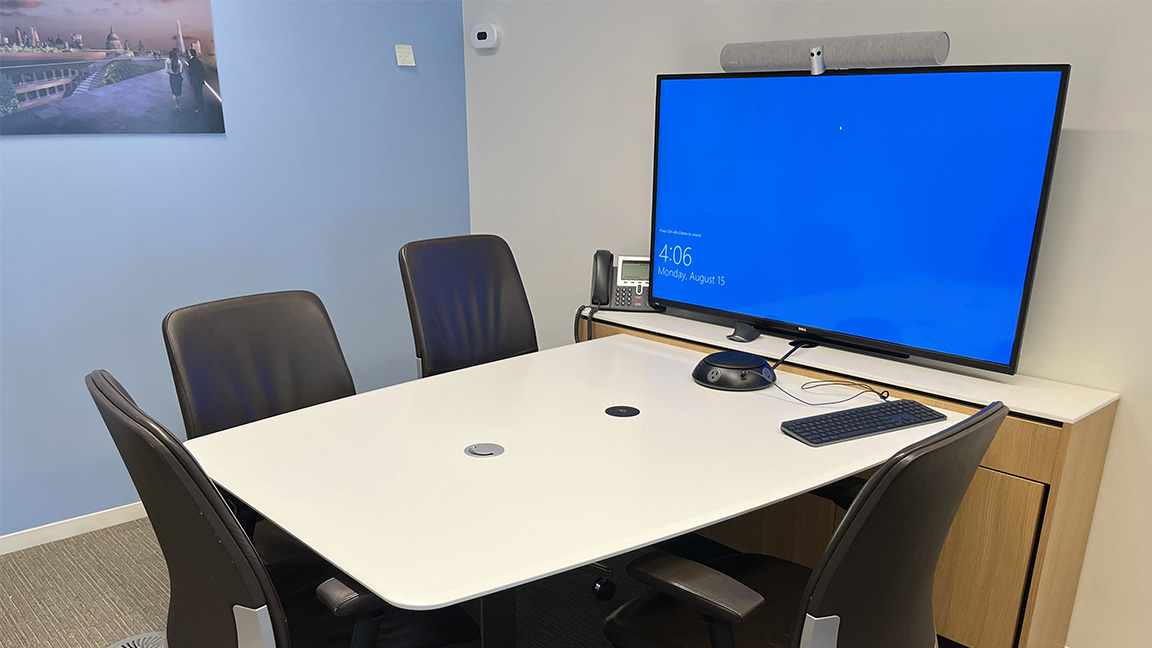
In a world where customers expect their AV systems to be always available, managed services make sense. Often provided by the integrator who installed their equipment, managed services mean 24/7 support for these systems, both to prevent problems through remote monitoring and regular servicing, as well as fixing problems quickly and economically when they occur.
[What to Know about AVI-SPL's New Global Enterprise Managed Services]
“An effective managed service must enable customers to outsource day-to-day support responsibility while applying a continuous improvement approach,” explained Karen Klosinski, AVI-SPL’s VP of products and solutions. “With AVI-SPL Enterprise Managed Services, we assume full responsibility for as-is environments, assess the current maturity level, and apply technology, business intelligence, and deep industry expertise to transform environments into simple-to-use, supportable, scalable, and secure business communication platforms.”
A Levelled Approach

As with most kinds of paid customer support, AV managed services are offered in a range of levels. “First line support is mostly geared towards taking the problem report in and coordinating getting somebody on site,” said Richard Mebane, VP of operations with Verrex, which offers AV integration services and managed services. “We have a second line of support that is more advanced, which provides next steps and troubleshooting to our customers’ AV staff to fix problems themselves.
"All this support is backed up by our project engineers, because the majority of our support is for AV systems that we installed," he continued. "So, the project engineers who engineered the system can be brought into the mix to resolve problems.”
[Cloud-Based Production: Opportunity or Threat for Integrators?]

At the PSNI Global Alliance, its latest managed services offering is a network operations center (NOC) service, which is available to and through any of the organization's Certified Solution Providers. It includes Tier 1-3 support as well as 24/7 access.
“We also offer monitoring services which include equipment monitoring, self-healing, room usage statistics, and more," added Steve Riley, PSNI's director of global professional services. "This service partnership enables organizations to ensure security, stability, and longevity across their AV and IT operational landscape. Our NOC service provides PSNI Certified Solution Providers the ability to proactively monitor their clients’ systems and provide remote resolution for networked hardware and offers advanced analytics and custom reporting.”
Reducing Truck Rolls
It is the ability of AV integrators to monitor, manage, and troubleshoot their customers’ AV equipment/systems remotely that makes managed services economically viable. “Coming out of the IP networking space, I would say that remote monitoring is critically important,” Mebane said. “You can't do managed services without it.”

While Klosinski agreed that remote monitoring and management are core to any managed service solution, they're not the only management practices that matter. "To have a meaningful impact on reliability and user experience, proactive and preventative measures are required," she said. "With both proactive and preventative strategies in place, we can solve today's problems while gaining insight into predicting and avoiding tomorrow's impact. We may reduce the number of truck rolls and we'll surely improve reliability and reduce operating cost.”
Reducing truck rolls matters—sending technicians to a site costs money that, inevitably, the customer will end up paying for one way or another.

“Remote monitoring does limit truck rolls,” said Shawn Fernandez, VP of business development with Solutionz, which introduced its Solutionz RMM remote monitoring and management platform last year. “To be able to go in remotely to a device and be able to reboot it, troubleshoot it, or send it code can solve problems from a distance and limits the amount of truck rolls that are usually required.”
In fact, the reduction in truck rolls made possible by remote monitoring is nothing short of impressive. “The statistics say that up to 40% of truck rolls can be solved remotely through remediation efforts and proper troubleshooting techniques,” Riley told SCN. “Not only can these issues likely be resolved remotely, but in the cases where they cannot, remote troubleshooting can ensure that a technician with the proper skillset is being sent to resolve the issue, because they have been properly informed of the issue.”
[Introducing OptixAV from Solutionz—What You Need to Know]
The best part: In most cases, no new infrastructure is required at the customer's site to enable remote monitoring. “That is one of the benefits of a managed service like AVI-SPL's Enterprise Managed Services,” said Klosinski. “We provide all the management applications and infrastructure required for asset tracking, monitoring, ticketing, and reporting. Customers need only establish a remote connection with a communications application installed in a virtual server environment.”
Then there's the caveat: Providing managed service to AV customers does come with costs attached for the AV integrator that offers them. Beyond the required equipment to support this service, there are also staffing considerations.
“In most cases, you can count on needing one on-site technician per $250K in annual revenue in the service department," Riley estimated. "A coordinator will be required to answer the phone and own the service ticket from its creation through closure—and again, depending on volume, this individual would also own the calendar and would be responsible for dispatching technicians as needed.”
'Win-Win' Proposition
AV managed services are a true "win-win" proposition for customers and integrators alike. For AV customers, paying a monthly fee for managed services maximizes the availability of their facilities. Not only does this justify their AV investments, but it ensures their usage on a daily basis, providing their business with the many advantages that on-tap AV has to offer.
"I would say that remote monitoring is critically important. You can't do managed services without it.”
Richard Mebane, Verrex
“It helps the end customer to get the most out of their AV spaces,” Riley said. “Keeping AV systems working takes regular maintenance, in addition to responding to service requests as they will, most likely, occur at the most inopportune moments. The aim of our NOC is to provide a fully managed support service for use by our Certified Solution Providers and the rollouts they are involved in, ensuring maximum uptime in system performance for enterprise customers, coupled with Tier 3 dispatch support through PSNI's 250-plus locations worldwide.”
[Integrators: Ready for Plug-In Possibilities?]
Managed services also help customers get the most mileage out of their AV systems, just as regular oil changes and other scheduled services keep cars on the road longer. This is why AVI-SPL strives to provide services and solutions "for all stages of the technology life cycle,” Klosinski said. “Managed services enable us to help our customers realize the business value of their technology investments."
Offering managed services is good for integrators as well, because it provides them with a regular revenue stream after the initial AV installations are complete. “I think it's significant and should progress to being more significant,” said Mebane. “Probably about 18% of our revenue is recurring and we keep trying to inch that up.”
“Managed service agreements hit your P&L [Profit and Loss] as deferred revenue, meaning it spreads the funds evenly across the coverage term,” Riley explained. “Also known as recurring revenue, this provides the integrator with a consistent stream of revenue throughout the year that can be counted on from quarter to quarter. For us, the benefits are twofold, with our Certified Solution Providers benefiting directly from PSNI's worldwide resources and their clients having ongoing support no matter their location. This service brings a strong foil to our offering, which, in turn, helps the company to grow.”
Not An Easy Sell?
There’s just one dark cloud in the blue skies of managed services: the reluctance of some customers to commit to regular payments.
“It's not as easy to sell managed services in the AV space as it is in the IP networking, where they understand its benefits,” Mebane explained. “In the IP world, when even a part of your network goes down, a whole lot of people are impacted in a whole lot of ways—whereas in the AV world, where a customer has 50 huddle rooms, if one goes down, it's not that big a deal.”

Another challenge in selling managed services is that customers can live without support until something goes wrong. “It's not like the software world where everything's turned into subscriptions and you need to write a check every year just to keep your service running or your software running,” Mebane added.
Riley argued a lack of understanding on the part of customers has a "great effect" on the ability to sell managed services. To address this, managed services sales teams need resources, such as a resource guide, complete with frequently asked questions, common objections, and pricing examples.
“Basically, everything a salesperson would need to know,” Riley added. “Often, service agreements are put at the end of the contract—and by doing this it makes the agreement feel optional. Put the service agreement as your first line item. Be proud of it. Be ready to talk about it.”
Again, there is some good news: There is growing interest and adoption of managed services among AV customers. “In many ways, this is directly related to the migration to cloud-based collaboration technologies during the pandemic," said Klosinski. "Organizations were able to quickly migrate to cloud-based collaboration platforms at that time, but many were not able to keep up with the IT staff demands and the learning curves that resulted. Our Enterprise Managed Service is a direct result of this demand, providing both 24/7 remote management and on-site dispatch when required for a more comprehensive approach.”
As for the future of managed services? Although none of the experts interviewed for this article expect their revenues to surpass money earned from actual AV installations, they do see managed services as a vital part of any AV integrator’s total cash flow. “If you get 5-10% of the project sales in managed services, that's good,” Mebane noted.
“I don't think there's any limit, and that revenue from managed services is going to be very, very important for us as we go forward,” added Fernandez. “I think we have a lot of organizations looking to outsource more so than ever before. It is also a lot easier to sell wider into an existing customer organization than it is to go find new clients, and so I think there's a lot of managed services that can be added to our portfolio that can be an important part of the bottom line.”







